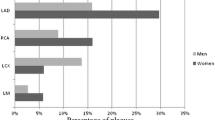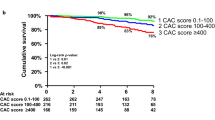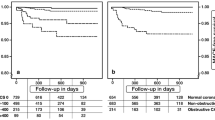Abstract
Background Coronary artery calcium scoring (CAC) is an excellent non-invasive method to evaluate coronary atherosclerotic burden. To better predict the risk of future events in an individual, their absolute CAC score is compared to an age- and gender-matched cohort in order to assign a percentile rank. However, it is unknown whether absolute CAC or percentile rank is better in predicting obstructive coronary artery disease (CAD). We hypothesized that absolute CAC is superior to percentile rank in predicting obstructive CAD. Methods 210 consecutive patients referred to our institution for CAC and coronary artery computed tomography angiography (CTA) were included. CAC scores were expressed as Agatston score; percentile rank as published by the Multi-Ethnic Study of Atherosclerosis. Coronary artery stenoses were graded semi-quantitatively. Receiver operating characteristics curves (ROC) were used to assess the performance of CAC to predict obstructive CAD. Results In the overall group, the area under the curve (AUC) was significantly greater for absolute CAC compared to MESA percentile rank in predicting obstructive CAD (0.80 vs. 0.72, P = 0.006). Subgroup analysis revealed similar findings: AUC for absolute CAC was greater than for MESA percentile rank in males (0.82 vs. 0.71, P = 0.008), females (0.78 vs. 0.72, P = 0.085), symptomatic patients (0.78 vs. 0.72, P = 0.067) and in asymptomatic subjects (0.89 vs. 0.74, P = 0.05). Conclusion Absolute CAC is superior to MESA percentile rank in predicting obstructive CAD. This finding was seen in both symptomatic and asymptomatic patients as well as in males and females.



Similar content being viewed by others
Abbreviations
- AUC:
-
Area under the curve
- CAC:
-
Coronary artery calcium score
- CAD:
-
Coronary artery disease
- CT:
-
Computed tomography
- CTA:
-
Coronary tomography angiography
- MDCT:
-
Multi detector computed tomography
- MESA:
-
Multi-Ethnic Study of Atherosclerosis
- MPI:
-
Myocardial perfusion imaging
- ROC:
-
Receiver operating characteristics
References
World Health Report 2002: Available at. http://www.worldheart.org. 2007. Ref Type: Generic
Fuster V, Badimon L, Badimon JJ, Chesebro JH (1992) The pathogenesis of coronary artery disease and the acute coronary syndromes (2). N Engl J Med 326:310–318
Zheng ZJ, Croft JB, Giles WH, Mensah GA (2001) Sudden cardiac death in the United States, 1989 to 1998. Circulation 104:2158–2163
Chambless LE, Heiss G, Folsom AR, Rosamond W, Szklo M, Sharrett AR, Clegg LX (1997) Association of coronary heart disease incidence with carotid arterial wall thickness and major risk factors: the Atherosclerosis Risk in Communities (ARIC) Study, 1987–1993. Am J Epidemiol 146:483–494
Kablak-Ziembicka A, Tracz W, Przewlocki T, Pieniazek P, Sokolowski A, Konieczynska M (2004) Association of increased carotid intima-media thickness with the extent of coronary artery disease. Heart 90:1286–1290
Budoff MJ, Georgiou D, Brody A, Agatston AS, Kennedy J, Wolfkiel C, Stanford W, Shields P, Lewis RJ, Janowitz WR, Rich S, Brundage BH (1996) Ultrafast computed tomography as a diagnostic modality in the detection of coronary artery disease: a multicenter study. Circulation 93:898–904
Guerci AD, Spadaro LA, Goodman KJ, Lledo-Perez A, Newstein D, Lerner G, Arad Y (1998) Comparison of electron beam computed tomography scanning and conventional risk factor assessment for the prediction of angiographic coronary artery disease. J Am Coll Cardiol 32:673–679
Arad Y, Spadaro LA, Goodman K, Newstein D, Guerci AD (2000) Prediction of coronary events with electron beam computed tomography. J Am Coll Cardiol 36:1253–1260
Hoff JA, Chomka EV, Krainik AJ, Daviglus M, Rich S, Kondos GT (2001) Age and gender distributions of coronary artery calcium detected by electron beam tomography in 35,246 adults. Am J Cardiol 87:1335–1339
Janowitz WR, Agatston AS, Kaplan G, Viamonte M Jr (1993) Differences in prevalence and extent of coronary artery calcium detected by ultrafast computed tomography in asymptomatic men and women. Am J Cardiol 72:247–254
McClelland RL, Chung H, Detrano R, Post W, Kronmal RA (2006) Distribution of coronary artery calcium by race, gender, and age: results from the Multi-Ethnic Study of Atherosclerosis (MESA). Circulation 113:30–37
Detrano R, Hsiai T, Wang S, Puentes G, Fallavollita J, Shields P, Stanford W, Wolfkiel C, Georgiou D, Budoff M, Reed J (1996) Prognostic value of coronary calcification and angiographic stenoses in patients undergoing coronary angiography. J Am Coll Cardiol 27:285–290
Gopal A, Nasir K, Chow DZ, Liu ST, Budoff MJ (2007) Coronary Artery Calcium Percentiles & Absolute Scores–which is a stronger predictor of mortality? J Am Coll Cardiol 49(Supplement 1):157A
Diamond GA, Forrester JS (1979) Analysis of probability as an aid in the clinical diagnosis of coronary-artery disease. N Engl J Med 300:1350–1358
Kennedy J, Shavelle R, Wang S, Budoff M, Detrano RC (1998) Coronary calcium and standard risk factors in symptomatic patients referred for coronary angiography. Am Heart J 135:696–702
Leber AW, Knez A, Mukherjee R, White C, Huber A, Becker A, Becker CR, Reiser M, Haberl R, Steinbeck G (2001) Usefulness of calcium scoring using electron beam computed tomography and noninvasive coronary angiography in patients with suspected coronary artery disease. Am J Cardiol 88:219–223
Shavelle DM, Budoff MJ, Lamont DH, Shavelle RM, Kennedy JM, Brundage BH (2000) Exercise testing and electron beam computed tomography in the evaluation of coronary artery disease. J Am Coll Cardiol 36:32–38
Laudon DA, Vukov LF, Breen JF, Rumberger JA, Wollan PC, Sheedy PF2 (1999) Use of electron-beam computed tomography in the evaluation of chest pain patients in the emergency department. Ann Emerg Med 33:15–21
Agatston AS, Janowitz WR, Hildner FJ, Zusmer NR, Viamonte M Jr., Detrano R (1990) Quantification of coronary artery calcium using ultrafast computed tomography. J Am Coll Cardiol 15:827–832
Greenland P, LaBree L, Azen SP, Doherty TM, Detrano RC (2004) Coronary artery calcium score combined with Framingham score for risk prediction in asymptomatic individuals. Jama 291:210–215
Raggi P, Callister TQ, Cooil B, He ZX, Lippolis NJ, Russo DJ, Zelinger A, Mahmarian JJ (2000) Identification of patients at increased risk of first unheralded acute myocardial infarction by electron-beam computed tomography. Circulation 101:850–855
Author information
Authors and Affiliations
Corresponding author
Rights and permissions
About this article
Cite this article
Akram, K., Voros, S. Absolute Coronary Artery Calcium Scores are superior to MESA percentile rank in predicting obstructive coronary artery disease. Int J Cardiovasc Imaging 24, 743–749 (2008). https://doi.org/10.1007/s10554-008-9305-5
Received:
Accepted:
Published:
Issue Date:
DOI: https://doi.org/10.1007/s10554-008-9305-5




